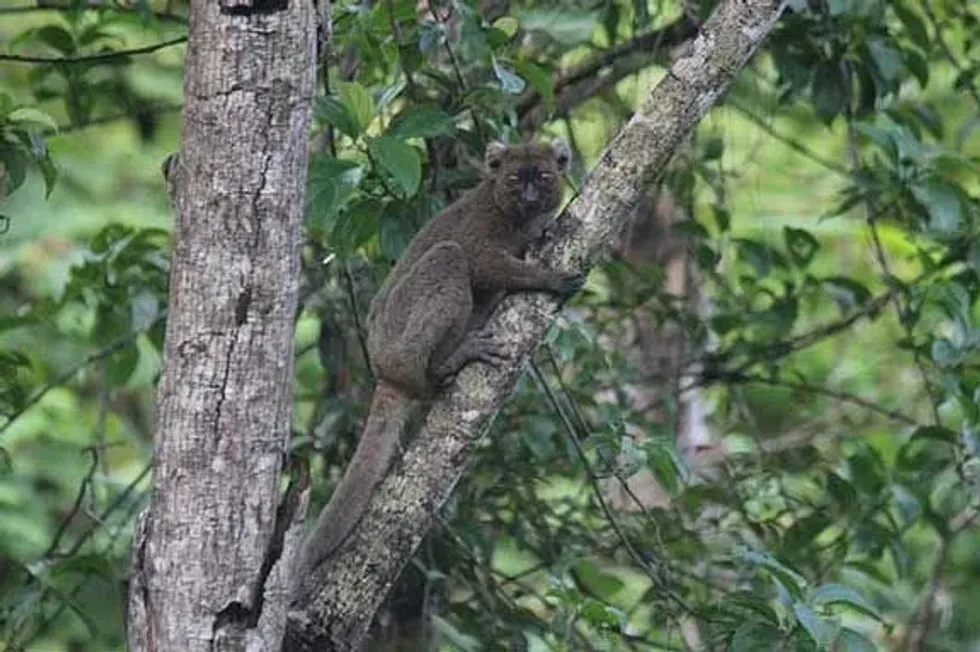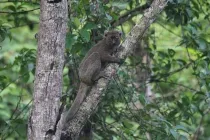Have you ever heard about a greater bamboo lemur (Prolemur simus)? A greater bamboo lemur is the largest bamboo lemur that belongs to the Lemuridae family. It is mostly identified by distinguishing white ear tufts.
It is also known as broad-nosed bamboo lemur or broad-nosed bamboo lemur. Greater bamboo lemur (Prolemur simus) is very fond of the bamboo species of Cathariostachys madagascariensis and their population is mostly found living on giant bamboo trees. They are very lazy and greedy animals.
This species is called Critically Endangered by the IUCN Red List. Their current range of habitat is restricted to the southeastern Madagascar range. There are many characteristics of these animals.
Wish to know more about it? Here are some fun, engaging, and interesting facts on greater bamboo lemur (genus Prolemur) which will make you more curious about them. Afterward, do have a look at our other articles on swamp monkey facts and dusky leaf monkey facts as well.
Greater Bamboo Lemur Interesting Facts
What type of animal is a greater bamboo lemur?
A greater bamboo lemur species (prolemur simus) is the largest bamboo lemur which is restricted to the southeastern Madagascar range. This primate belongs to the lemuridae family and lives on giant bamboo trees.
They are known for their distinguishing white ear tufts. A greater bamboo lemur is also known as broad-nosed bamboo lemur or broad-nosed gentle lemur (hapalemur simus). Their primary diet includes a particular bamboo species.
Their population is becoming alarmingly low and is one of the World’s 25 Endangered Primates. These animals are lazy and reclusive in their current range of habitat across Madagascar.
What class of animal does a greater bamboo lemur belong to?
A greater bamboo lemur species (Prolemur simus) is a giant bamboo lemur from Madagascar that belongs to the Mammalian class due to its ability to give birth to young ones. They come under the primates order and belong to the family of Lemuridae.
Its scientific name is Prolemur simus. They are critically endangered and on the verge of extinction. This primate is also known as broad-nosed bamboo lemurs (Hapalemur simus).
How many greater bamboo lemur are there in the world?
According to global estimates, there are about 500 greater bamboo lemurs left in the world, when all the populations are combined. There are only 100-160 greater bamboo lemurs left in the wild habitat range of these animals. This species of lemur from Madagascar is on the verge of extinction and are one of the World’s 25 Endangered Primates.
Where does a greater bamboo lemur live?
A greater bamboo lemur (prolemur simus) has its natural habitat in the forests. The distribution range of the groups of these animals is restricted to all the regions of Madagascar. Ranomafana and Andringitra National Park are a part of the current distribution range in Madagascar.
What is a greater bamboo lemur's habitat?
A greater bamboo lemur usually prefers humid primary rainforests. They prefer areas where plenty of bamboo trees are present. Their homes are usually built on bamboo thickets. Their groups are only restricted to the Madagascar range. They are sometimes seen in degraded habitats where bamboo may not be present. Groups of lemurs are also seen in National Parks.
Who do greater bamboo lemur live with?
A greater bamboo lemur is a social creature and prefers to live in groups with 28 or more members. They are sometimes seen alone too and the solitary ones are very gregarious.
How long does a greater bamboo lemur live?
A greater bamboo lemur (eastern hapalemur simus) has an average life span of around 17 years in the wild. The age in the captivity is not known yet. The maximum age or life span of this species may vary depending on the habitat and diet of the animal.
How do they reproduce?
The breeding season of greater bamboo lemur primate is between May and June and gives birth during November. A female greater bamboo lemur gives birth to an offspring during the breeding season after and the gestation period is 149 days. Female greater bamboo lemurs take care of their young ones who will wean after eight months.
What is their conservation status?
The populations of a greater bamboo lemur are listed under the 25 most endangered primates or species by the IUCN Red list. They are one of the world’s 25 most endangered primates facing multiple threats to their existence.
They are at the verge of extinction and only a few are left. The main reasons for the decrease are slash and burn agriculture, degrading of the habitat, mining, cutting of bamboo trees, and overuse of bamboo and hunting.
Greater Bamboo Lemur Fun Facts
What do greater bamboo lemur look like?
A greater bamboo lemur is the largest bamboo lemur that belongs to the Lemuridae family. Their coats are reddish brown to olive brown in color. They have long tails along with long back legs. They have a distinguishing feature, that is, the presence of tufts of white fur on the ears.
They have an olive brown head and neck with a broad nose. They are the largest of three species and the face is dark gray in color. They have two tongues.
How cute are they?
A greater bamboo lemur is a very social animal and uses different types of calls. They are cute in their appearance.
How do they communicate?
Greater bamboo lemurs use sound for communicating with each other. They have two types of calls, one is the contact and the other is the alarm call.
Contact calls have a strong helpful sound and the intensity rises and falls rapidly. A greater bamboo lemur makes alarming calls when they feel frightened and makes a low-pitched roar which is longer and the intensity decreases.
How big is a greater bamboo lemur?
A greater bamboo lemur has a body length of of 14.5 in (35 cm) and is the largest bamboo lemur residing in forests. Their length is bigger than a golden bamboo lemur.
How fast can a greater bamboo lemur run?
These primates are blessed with an agile body which allows them to move across their habitat in the forest with relative ease. Though, the exact speed of these animals in forests is not known.
How much does a greater bamboo lemur weigh?
An average greater bamboo lemur weighs around 2.2-5.5 lb (1-2.5 kg). This may vary depending on their food habits and surroundings.
What are the male and female names of the species?
As the greater bamboo lemur is a lemur, its species is p. simus. A male greater bamboo lemur does not have any specific name but a female greater bamboo lemur is called a princess.
What would you call a baby greater bamboo lemur?
A baby greater bamboo lemur is called a pup. The gestation period is 149 days and the weaning period is eight months.
What do they eat?
Greater bamboo lemurs are herbivores as they only feed on the green. Their primary diet consists of the shoots, pith and leaves of bamboo species cathariostachys madagascariensis.
Cyanide is present in the bamboo shoots and their metabolism is not known. Their powerful jaws help them to tear bamboo apart and specialized molars for eating them. The 2 % of its diet includes flowers, fruits, and leaves.
Main predators of greater bamboo lemur include fossa and bushpigs.
How active are they?
Greater bamboo lemurs are active during dusk and dawn. They spend most of their active time eating bamboo as their primary diet is the bamboo species. They can be lazy at times too.
Would they make a good pet?
No, greater bamboo lemurs are not suitable for keeping as pets. They are wild animals and are one of the world’s 25 Endangered Primates. They are listed as Critically Endangered species by the IUCN Red List. They are not at all suitable for keeping as pets. But they are seen in National Parks.
Did you know...
Greater bamboo lemurs are the largest bamboo lemur and have the least population compared to the other species. Young greater bamboo lemurs like to suck their thumb.
The golden bamboo lemur, a relative of the greater bamboo lemur, is also a Critically Endangered species but is not yet extinct.
Most lemurs are arboreal, and only seek out water for drinking and do not swim.
Several species of lemurs have eyes capable of detecting color at night, which is a form of night vision that allows them to identify the leaves with highest protein content.
Why is the greater bamboo lemur endangered?
A greater bamboo lemur bamboo is one of the World’s 25 Endangered Primates. Lemurs’ population is decreasing at an alarming rate and is listed as a Critically Endangered species by IUCN Red List.
The main reasons for their decreasing population are slash and burn agriculture which destroys their habitat, cutting of bamboo trees, mining and hunting in some regions. The fragmentation and distribution of the population is also a major cause.
Parasite burden is seen in greater bamboo lemurs that live in the lowland areas which can badly affect their lifespan and health. Other primates in the World’s 25 Endangered Primates include Indri, red-ruffed lemur, and eastern lowland gorilla.
Do lemurs have two tongues?
Yes. Lemurs have two tongues. There is the main tongue and the second tongue is under the tongue.
One tongue is used for eating and drinking. The under the tongue is situated below the tip of the main tongue like an extension. The under the tongue is used as a toothbrush for removing hair and debris from the tooth comb.
Here at Kidadl, we have carefully created lots of interesting family-friendly animal facts for everyone to discover! For more relatable content, check out these langur monkey facts or Greenland dog facts pages.
You can even occupy yourself at home by coloring in one of our free printable Greater bamboo lemur coloring pages.







